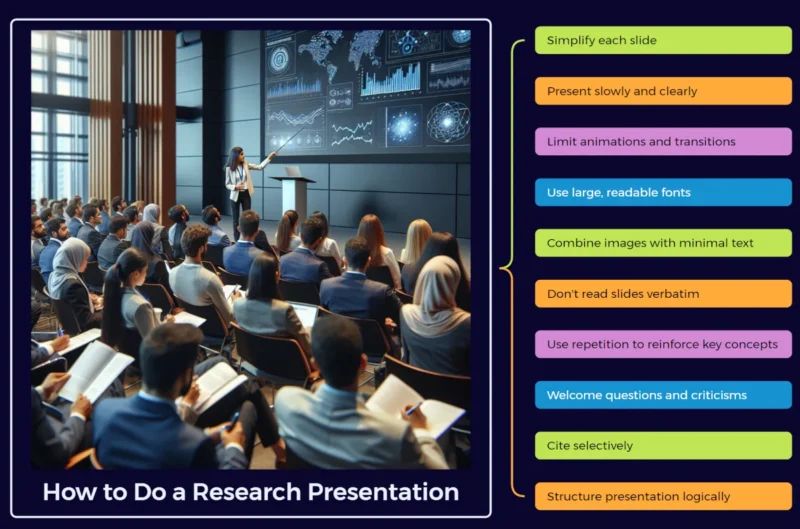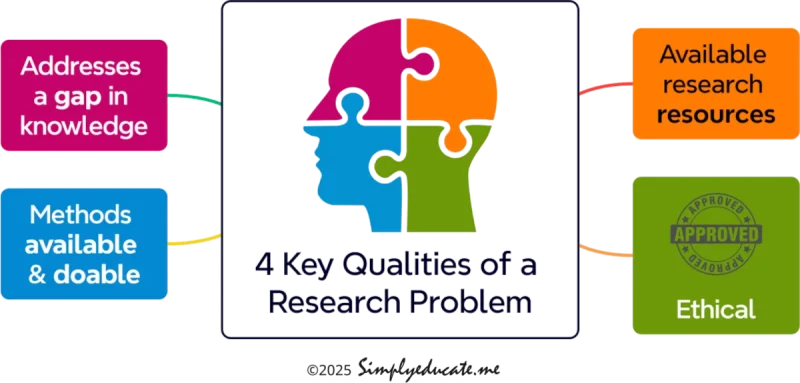
Are you preparing to present your research paper at a conference, symposium, or academic forum? Knowing how to do a research presentation effectively can make or break your credibility as a scholar or professional.
While PowerPoint templates make slide creation easier, successful presentations go beyond good design — they require clarity, confidence, and a strategic approach to communication. This research presentation guide, based on actual experience, will help you along the way.
Table of Contents
10 Tips on How to Do a Research Presentation and Win
If you’ve ever struggled to fit your study into a 10-minute talk or keep your audience engaged, these ten expert tips on how to present findings will help you craft a powerful and memorable research presentation. If it’s a competitive one, these tips can help place you make it at the top of the presentations.
1. Simplify Each Slide
When you have only 10 to 15 minutes to present, simplicity is key. Focus on your most important findings and insights. Each slide should contain no more than three concise lines of text. Your audience should grasp your message in just a few seconds.
Remember, your goal is clarity — not information overload. After your talk, interested participants can approach you for more details. In a large conference, you will be fortunate to present more than 30 minutes. Chances are, you are only given a limited time of 15 to 20 minutes.
2. Present Slowly and Clearly
Delivering fewer points clearly is far more effective than rushing through too many. Speak at a deliberate pace to ensure your audience understands your main points. Pause briefly between ideas — comprehension is more valuable than speed. Let your ideas, or main points, sink.
3. Limit Animations and Transitions
While animations can make your presentation visually appealing, overusing them can distract your audience. Avoid excessive slide effects that slow down your flow or divert attention from your research findings. Keep transitions simple and professional and timed to match the time allocated for presentation.
4. Use Large, Readable Fonts
Use sans-serif fonts such as Arial or Helvetica with a minimum size of 16 points to maintain readability even from a distance. Clear, uniform fonts demonstrate professionalism and help your audience focus on your content rather than your design.
5. Combine Images with Minimal Text
A well-chosen image can communicate complex ideas instantly. Use high-quality visuals with a few lines of text that reinforce your message.
A picture truly is worth a thousand words — especially in a research presentation where clarity matters. A blurred picture or diagram, or an out-of-aspect or disproportionate one, can significantly affect the audience’s impression of the overall quality of your research presentation.

Make the accompanying text informative but not too long. A phrase may be enough to provide more information about the picture or diagram.
6. Don’t Read Your Slides Verbatim
Your slides should guide your talk, not serve as a script. Instead of reading word-for-word, explain your slides naturally. This demonstrates mastery of your topic and keeps the audience engaged. Judges and peers appreciate confident presenters who speak with understanding.
7. Use Repetition to Reinforce Key Concepts
Repetition is a teaching tool. Define new or complex terms clearly and repeat them once in a while throughout your talk to reinforce understanding. In a diverse academic audience, this ensures that everyone follows your line of thought.
8. Welcome Questions and Criticism Gracefully
Presenting your research findings gives you an opportunity to improve on it. When audience members ask questions or offer constructive criticism, accept them with openness and respect. You might gain valuable insights or identify overlooked aspects of your study before you decide to publish research findings.
9. Cite Selectively
Avoid citing too many references during your talk. Instead, highlight only the most relevant studies that show the knowledge gap your research addresses. Focus your time on presenting your own findings and their implications.
10. Structure Your Presentation Logically
A well-organized presentation follows a logical flow:
- Introduction – Explain why you conducted the study.
- Methodology – Briefly describe how the research was done.
- Results – Present key findings concisely.
- Discussion and Conclusion – Interpret your results and suggest recommendations.
End your presentation with a strong closing statement that summarizes your contribution and leaves your audience thinking about your work.
Final Reflections
Mastering how to do a research presentation takes practice and planning. By simplifying your slides, speaking with confidence, and organizing your content logically, among other research presentation tips mentioned in this article, you can effectively communicate your research to any audience — from academic peers to policymakers. Remember: clarity, not complexity, is what makes your research presentation stand out.
FAQ: How to Do a Research Presentation
Q1. How do I start a research presentation?
Begin with a strong opening — introduce yourself, your topic, and the purpose of your research. A brief context or question can engage your audience immediately.
Q2. How many slides should I prepare for a 10–15 minute research presentation?
Prepare about 10–12 slides, spending roughly one minute per slide. Keep them concise and visually clear.
Q3. What makes a good research presentation?
A good presentation is clear, focused, and well-organized. It uses visuals effectively, avoids clutter, and communicates the main findings confidently.
Q4. Should I memorize my script?
No. Familiarize yourself with the flow of your presentation instead of memorizing it word-for-word. Speak naturally to keep your delivery engaging.
Q5. How do I handle difficult questions from the audience?
Stay calm and professional. If you don’t know the answer, acknowledge the question and offer to follow up after the presentation.


